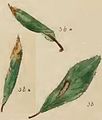|
Parornix torquillella
Parornix torquillella is a moth of the family Gracillariidae found in Europe. The larvae mine the leaves of Prunus species, such as blackthorn (Prunus spinosa). It was described by the German entomologist Philipp Christoph Zeller in 1850, from specimens found in Florence, Leghorn and Pisa. DescriptionThe wingspan is 9–13 mm.[2] The head is pale ochreous mixed with fuscous. Palpi white. Forewings are rather dark fuscous, purplish-tinged, towards dorsum and costa more blackish numerous costal streaks, a spot in disc posteriorly, and two or three dorsal spots white; a black apical dot, strongly white edged anteriorly; cilia with three entire dark fuscous lines. Hind wings are grey. The larva is pale yellow -green; dorsal line dark green or reddish; head pale yellow; segment 2 with four black spots.[3][4][5] Very similar to Parornix finitimella genitalia examination is necessary to identify both. The larvae feed on dwarf cherry (Prunus cerasus), plums (Prunus domestica), Damson (Prunus insititia), beach plum (Prunus maritima) and blackthorn (Prunus spinosa). They mine the leaves of their host plant.[6] DistributionIt is known from all of Europe, except Spain and parts of the Balkan Peninsula. Gallery
TaxonomyThe genus Paronix comes from para, meaning alongside and ornix named after the genus Ornix Treitschke, 1833, which refers to ornis, a bird. The genus Ornix originally included a wide range of feathery-winged microlepidoptera in the Coleophoridae and the Gracillariidae. Ornix was an early synonym of the genus Coleophora as a number of moths were name after birds. The feathery-winged moths were later restricted to Paronix. The specific name torquillella comes from torquis – a collar, ″from the prothoracic plate of the larva, which consists of four transversely placed black spots.[7] References
External links |
||||||||||||||||||||||||||||||
Portal di Ensiklopedia Dunia



